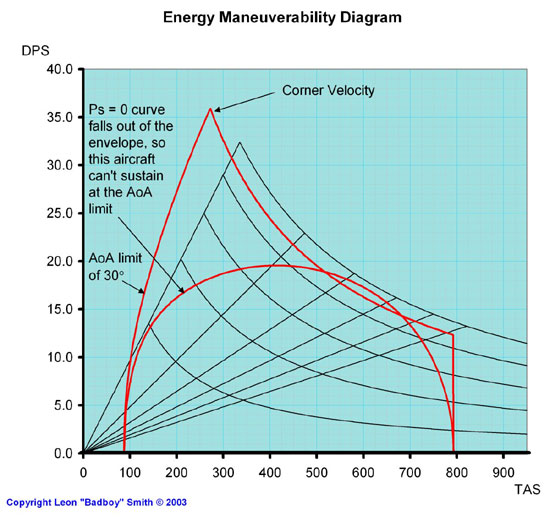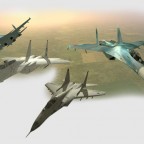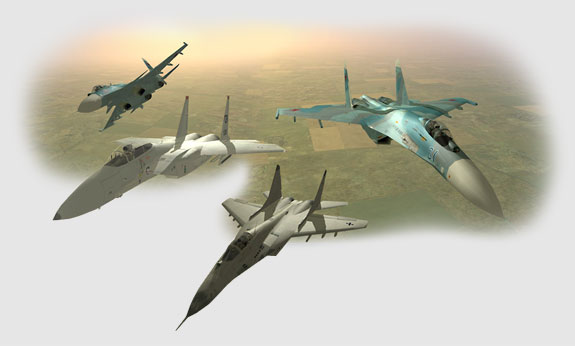Now examine the diagram for a 30° AoA limit shown in Figure Five and you notice that the aircraft will bleed all the way down to a zero sustained turn rate. By now it should be obvious that pulling all the way back on the stick is very undesirable. The harder you pull back on the stick, the slower you will end up turning. Now temper that thought with the idea that in aircraft like the F-15 and MiG-29 there are actually no hard AoA limits imposed by the control system, if you pull back hard enough and fast enough you may well have the control power to generate high pitch rates and exceed safe AoA limits, with the associated risk of rapid energy loss or departure.
The real penalty for being heavy handed with the flight control stick is that at lower speeds, the sustained turn rate drops significantly… The simple fact is that restraint can pay off, because your best sustained turn rate occurs at a lower G value than you can actually achieve. One of those situations where less is more. The fact that this is counter intuitive, and because it is very difficult to exercise the self control required in the heat of combat, is what makes it difficult to do. It is also why the idea is lost to so many virtual pilots, and why those who understand, seem to win their online engagements more easily, and have less trouble against the AI offline. That’s where practice and experience can help. So how do you use this knowledge in combat?
Figure Five
The short answer is simple, as a rule of thumb, modern jet fighters have their best sustained turn rates somewhere close to their corner velocity, so when you enter a hard turn starting above corner velocity, pull all the way to your G tolerance, and bleed off speed until you reach corner velocity. Once there, try to use only enough G so that you can sustain corner velocity. The advantages of that are three fold, firstly you can optimize your sustained turn rate. Secondly, being at corner velocity means that you have your maximum instantaneous turn rate available to you if you need it, and thirdly you may still be fast enough at corner velocity to execute an effective missile defense, while keeping your escape window at least partially open.
That begs the question, what are the corner velocities for the fighters in LOMAC? Fortunately I have been able to determine those values for the configuration available in the Fast Battle Planner of Medium Fuel, Guns Only and at Sea Level. The MiG-29 A and S variants have almost identical corner velocities of 685km/h or 370kts, while the F-15 has a lower corner velocity of 630km/h or 340kts, and the Su-27 has a corner velocity of 545km/h or 295kts. The Su-33 has a corner velocity of 590km/h or 320kts. It is worth noting that the corner velocity increases with aircraft weight, so with more fuel and weapons the corner velocities will be higher.
So how do those four aircraft compare in terms of their maximum instantaneous turns? In the configuration mentioned above, the F-15 is best with a maximum instantaneous turn rate of 26.5 degrees per second and a turn radius of 1250ft, the Su-27 is next with a maximum instantaneous turn rate of just under 25 degrees per second and a turn radius of 1150ft. Followed by the Su-33 with a maximum instantaneous turn rate of 24 degrees per second and a turn radius of 1280ft. The MiG-29 also has a maximum instantaneous turn rate of 24 degrees per second with a turn radius of 1490ft. Those details are presented in the following table for clarity.
| Aircraft Type | Corner Velocity (Km/h) |
Turn Rate Degrees/sec |
Turn Radius (feet) |
| F-15 | 630 | 26.5 | 1250 |
| Su-27 | 545 | 25 | 1150 |
| Su-33 | 590 | 24 | 1280 |
| MiG-29 | 685 | 24 | 1490 |
The last question then, suppose you just can’t sustain corner velocity, and you end up flying at a maximum AoA sustained turn, that is right on the edge of the envelope? For the four fighters previously discussed, the turn rate and turn radius in that situation is shown inFigure Six below, each aircraft turning in full afterburner.
Figure Six

















